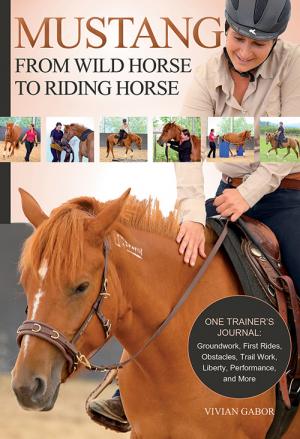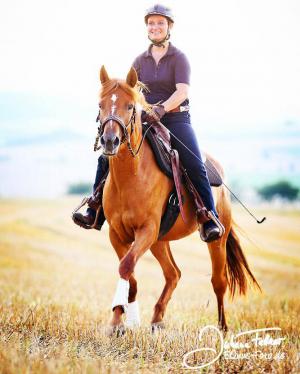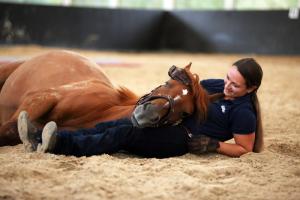Mustang is Dr. Vivian Gabor’s Trainer’s Journal about training an American Mustang. Her journal takes the reader every step of the way in her 90-day training program as she prepares the young Mustang, named “Mona,” for the Mustang Makeover Germany 2017. Originally published in German in 2018, Trafalgar Square Books published the English translation in 2020.
Gabor has a degree in Biology with a major in Animal Physiology and a doctorate in Equine Science with a focus on Equine Learning Behavior. Combining her educational background with her talent to successfully work with horses, she formed her own business: The German Institute for Behaviour and Communication.
Gabor writes: “The Makeover taught me to look at some aspects of horse training and how we deal with horses from a completely different perspective – the horse’s perspective.” She writes in the book, “We often take for granted the things that we expect from our horses, many of which make no sense to them.”
That is what I liked about this book. Gabor is completely empathetic with the horse’s perspective, and she constantly studies the horse’s reaction to what she does and adjusts her movements, training schedule accordingly. Her approach is to mold the behavior of the horse through the concepts of consequence and reward, and by creating awareness of the trainer’s own body language and how the horse perceives it.
She is frequently impressed with how smart this Mustang mare is and how quickly she progresses after just a few repetitions. She stresses the importance of allowing horses to find a solution that is rewarding and to encourage their active participation in solution-finding. She finds that Mona is also less “flighty” than some domesticated horses in many situations.
“Curiosity is a horse’s essential drive to explore his world, sizing up what could be dangerous and what can help his survival. Curiosity is closely linked with learning behavior and dealing with new situations,” Gabor explains. So she incorporates the horse’s natural curiosity into allowing the horse to problem-solve.
So many things that we take for granted that we can do with our domestic horses are, at first, impossible to do with a Mustang, such as just clipping a lead rope to a halter and being able to touch the horse all over its body, e.g., while grooming. Gabor learns from this first lesson, of removing and re-attaching the lead rope to the halter, that nothing will be achieved with speed.
The first step in training is to lay the foundations for respect and trust, keeping the horse attentive and relaxed. She also goes through the steps she takes in teaching the horse to be groomed and to have its feet picked up in preparation for the farrier.
The book progresses week by week, and day by day within each week, following the slow, steady progression of training. Interspersed throughout are blocks of terminology explanation that are helpful, yet distracting, from the narrative of the training sessions. She clearly explains operant conditioning – reinforcing a behavior that is initially shown at random to encourage repeating the behavior by associating it with a positive outcome, and demonstrates how she uses this method.
She writes that people can be too quick to exploit a moment of desired behavior and move too quickly. “Outsmarting destroys trust,” she writes. “Being outsmarted [by the human] only shows the horse that cooperating, being curious, or even listening to the person is punished. The feeling of self-efficacy is taken away from the horse.”
Even if you’re not training a Mustang, or training a domesticated horse, you will still find some of these lessons helpful with your own trained horse. For example, head-lowering for relaxation is an exercise that is “extremely important to me because it allows me to get the horse to assume a relaxed position at any time. Lowered head posture goes hand in hand with relaxation of the back and neck muscles and puts the horse in a comfortable physical state,” Gabor writes. What a great lesson for all horses and riders!
Another lesson for horse owners is that “horses naturally pay attention to body tension.” In most lessons with Mona, Gabor is attuned to how her own body tension affects Mona’s reaction. “My movements are very matter of fact, but careful,” she writes. “Horses can differentiate between the subtlest body language signals. Horses use gestures, facial expressions, and body tension to signal whether another horse should move away or approach them.” Gabor incorporates this awareness into her own body language and training program with Mona.
Getting a horse to concentrate on the rider when he encounters a something new or frightening is another valuable lesson. “A horse can only pay attention to one thing, so I direct his attention to me and my signals. The horse learns more and more to focus on the person and trust her, even in situations where he feels unsure,” Gabor explains.
This leads to the importance of being able to transfer knowledge to new, different situations and to new places. This is vitally important when a horse’s surroundings change. “In this situation, you should make the horse feel secure by doing familiar exercises so that he can relax in the new environment.”
Relieving pressure is another valuable training tool. “It must be immediately clear to the horse that there is a way to relieve pressure. He must not be kept under pressure for too long, as this causes unnecessary stress,” she says.
I’ve seen many riders whose horses move away from them when they are trying to mount. Gabor’s lesson in “lateral movement toward me” would be very helpful to these riders. Read how she uses operant conditioning to achieve this on pp. 48-49, especially “Parking” at the Mounting Block (51).
Week 4 of the second month provides a good lesson for dressage riders (and other disciplines): working on softness and self-carriage under saddle.
Most horse folks know that a familiar routine gives a horse security. With whatever lesson she is teaching Mona, she shows her that there is always a solution, and always includes something familiar, which ends with peace and relaxation. “The ability to associate situations with positive or negative feelings is crucial for horses’ survival. When we put young horses in a new situation, it should at least end on a good note so they can store it as a positive experience.”
Gabor takes the reader through the steps toward saddling for the first time, practicing standing tied (a lesson for some of our domesticated horses, too), ground driving, trailer training, and work at liberty.
The finale takes the reader to the Mustang Makeover 2017 with some great photos of the various aspects of their performance. For their Freestyle, Gabor rides in dressed as James Bond to the theme of Goldeneye. During this routine, Gabor chucks her James Bond attire to become a “Bond girl.” Then they demonstrate a few exercises on the ground to some very peaceful music.
The saddest part after the event is the auction of the Mustangs, when two sisters buy Mona. “I feel churned up inside and wonder what will happen with Mona next. Will the new owners get on well with her and Mona with them?” Gabor asks. The good news is that Mona’s new home won’t be too far away from Gabor’s place and, after getting to know them, she finds that they are a good match for the horse. Still, it’s hard loading Mona in the trailer to send her to her new home.
Gabor concludes: “I had never thought that I would change and grow so much as a result of an encounter with a horse. During the time with the Mustang, my awareness intensified, especially for how horses think and how they see things. It encouraged me to rethink common training methods. And I would encourage you to do the same!”
Find more information about the German Mustang Makeover at: https://www.mustangmakeover.de/index.php?id=616.Visit the page with the Mustangs 2017, and then click on TAG 3219 to see more about Mona and “Team Vivian.” There are photos from the event and slideshows of Vivian training and riding Mona. https://www.mustangmakeover.de/mustang-makeover/events-2017-2019/mustang-makeover-2017/mustangs-ueberblick/tag-3219/










